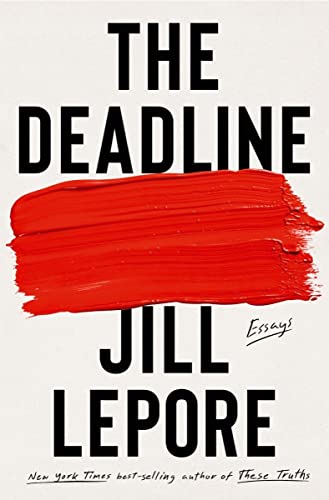The Deadline: Essays

“Without doubt, this book seems bound to win new followers for this irresistible writer.”
It is one thing to read the occasional essay by Jill Lepore in The New Yorker, and quite another to be thrilled by the prospect of a 630-page collection of her exquisite pieces published over the past decade in that magazine.
The Deadline, nothing less than a Jill Lepore treasury, gathers the author’s distinctive takes on Barbie and other dolls, Herman Melville, Dr. Who, the founder of the cryonics movement, police killings, dystopian novels, Roger Ailes, the Volkswagen bus, loneliness, and Donald Trump.
Intrigued? Consider these writings are the product of the mind of one of our leading historians, a woman whose curiosity is insatiable, and whose writing is bright, crisp, inventive, surprising, and a constant delight.
She has always wanted to be a writer, says this David Kempner ’41 Professor of American History at Harvard University (as if we couldn’t tell). She grew up on a street named for Benjamin Franklin, in a small Massachusetts town. Her father was a school principal who hired her mother as an art teacher and left a poem in her mailbox every day. One read “Marjorie, Marjorie, let me park my car in your garagery.”
Lepore appreciates that with the same fervor she brings to Melville and Ahab, to Robert L. Ripley’s 27-room mansion filled with “queeriosities,” and to the work of Robert C.W. Ettinger, who “thinks death is for chumps” and freezes corpses in vats of liquid nitrogen at -320 degrees Fahrenheit, presumable to emerge young and strong many years from now, even though “the consensus appears to be that when you try to defrost a frozen corpse you get mush.”
In Joe Gould’s Teeth, The Secret History of Wonder Woman, and many other books, she has brought to life figures from literature and history. But she does just as nicely in short pieces, writing about people as if she knew them. Take Eugene V. Debs (1855–1926), the American socialist and trade unionist who ran for president from prison:
“Debs was a tall man, lanky and rubbery, like a noodle. He had deep-set blue eyes and lost his hair early, and he talked with his hands. When he gave speeches, he leaned toward the crowd, and the veins of his temples bulged. He was clean-shaven and favored bow ties and sometimes looked lost in crumpled, baggy suits. He had a way of hunching his shoulders that you often see, and admire, in tall men who don’t like to tower over other people.”
In a recent graphic biography, Debs “looks like an R. Crumb character, though not so bedraggled and neurotic,” she writes.
Rachel Carson, she tells us, was “fiercely proud” of Silent Spring, which was “no slouch” of a book: “it launched the environmental movement, provoked the passage of the Clean Air Act (1963), the Wilderness Act (1964), the National Environmental Policy Act (1969),” not to mention the establishment of the Environmental Protection Agency (1970).
Carson kept her cancer secret “because she was a private person, but also because she didn’t want to give the chemical companies the chance to dismiss her work as having been motivated by her illness.” She didn’t want them to pull their punches. “The harder they came after her, the worse they’d look.”
As for that science fiction character Dr. Who, Lepore notes that “one reason Doctor Who spanned a half century is a casting trick written into the plot. When William Hartnell could no longer play the role, it was decided that the Doctor would be able to regenerate when he is on the verge of death, returning to life in another body. Between 1963 and 1989 seven actors played the Doctor. The show earned a cult following.”
Without doubt, this book seems bound to win new followers for this irresistible writer.